Parasound JC5 Stereo Amplifier by Greg Simmons
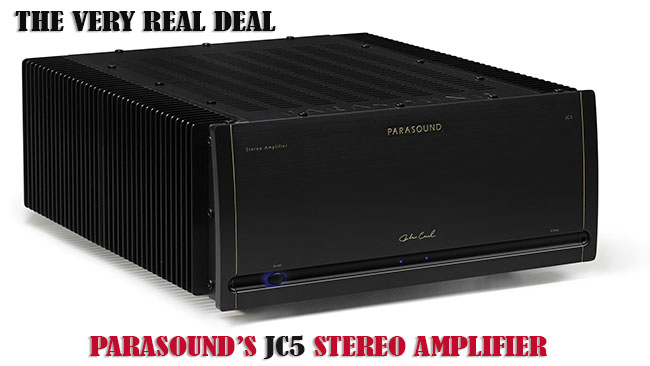
 They’re Coming…and They’re Mean!
They’re Coming…and They’re Mean!
Any minute now, there’s going to be a violent pounding on the door, a torch-wielding mob, or maybe a brick with a threatening note crashing through the living room window. The Vacuum Tube Fanatics of America will be revoking my decade-plus membership for the cardinal sin of buying a sand amp. “It’s heresy!” they’ll scream.
It’s true, though. I have enjoyed a great beast of a tube amp for the past eleven years. But when the time came to make a change, I went in the opposite direction, switching to solid-state power. Two things drove the decision: there were certain sonic improvements I was looking for, of course, but equally important, I wanted an amplifier that was plain-and-simply easier to live with. My outgoing amplifier ate KT88s like my Labrador Retriever eats kibble, and it barfed them back up half-chewed with almost as much frequency (Hork, hork, hork… *Bleahhk*… Oh look! A tetrode. Who’s a Good Boy?!). I am certain I spent more money replacing valves than I did buying the amp in the first place, and over the course of a decade, that became both frustrating and expensive. I want to listen to my amplifier, not fight with it.
Besides, my preamp and phono stage still have thirteen additional tubes between them, so it’s not as though I’ve sworn off the bottles entirely. I might perish without a hair of the dog.
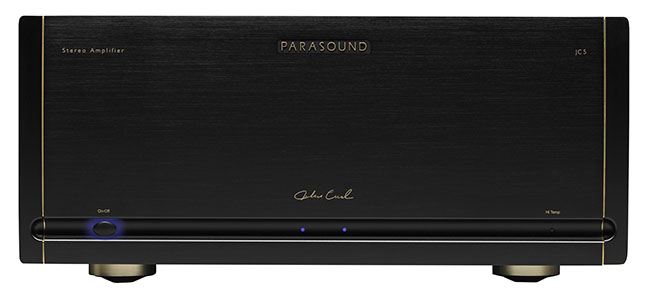
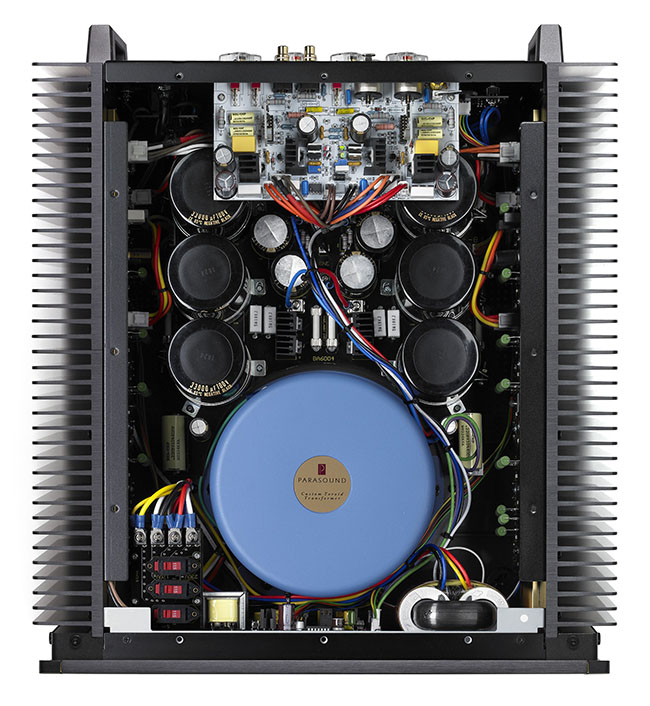
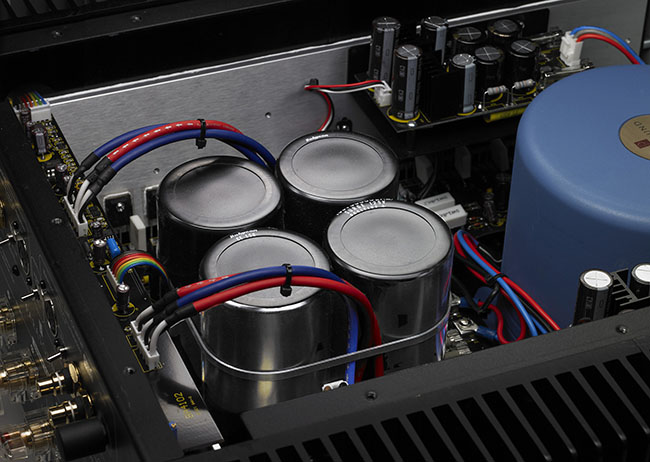
The Parasound JC5 Stereo Amplifier
The Parasound JC5 stereo power amplifier is a high-power, high-current, class A/B amplifier delivering 400 watts into an 8-Ohm load and 600 watts into 4-ohms. The first twelve watts are pure Class A. According to Parasound, the output watts will continue to increase another fifteen to twenty percent down to an amplifier punishing 1.5-Ohm load. On the outside chance you actually do require more power, a second JC5 bridged into mono will provide 1200 watts into an 8-Ohm load. No wimpy amplifiers here.

The JC5 is the common industry width of seventeen inches wide, but it’s also eight inches high, and twenty-two inches deep, including the rack handles on the back. This amplifier is large. Its four puck feet fit securely onto my Mapleshade rack with less than an inch to spare, though having the binding posts hanging over the back edge of the shelf does leave more room for maneuvering speaker cables. Heat sinks run down both sides of the JC5.
The JC5 weighs in at almost eighty pounds, so the aforementioned rear handles are truly useful for moving this amp around. They are very sturdy, no mere decorative afterthought.
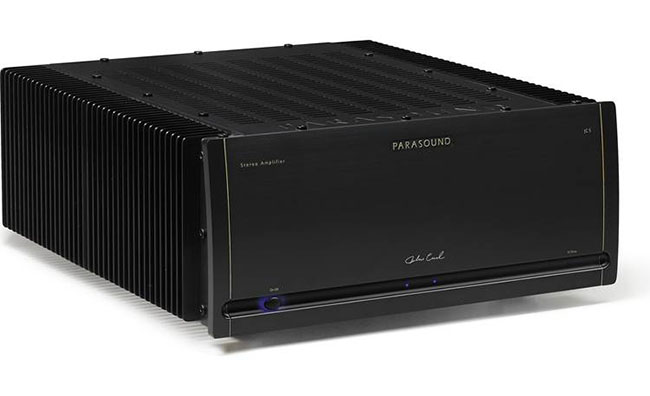
Business in the Front
I ordered this JC5 in Black, which includes a bit of gold trim. Designer John Curl’s signature shares the front panel with the Parasound logo and two vertical gold lines on the sides of the faceplate. Some might find the JC5 in black to be a bit somber, but it’s also available in silver which may be a little friendlier looking. There are a couple of blue LEDs indicating power-on and channel function. There is also a red LED to warn if the amplifier has over-heated, but after running the JC5 for four months, I’ve never seen it come on, which is for the best.
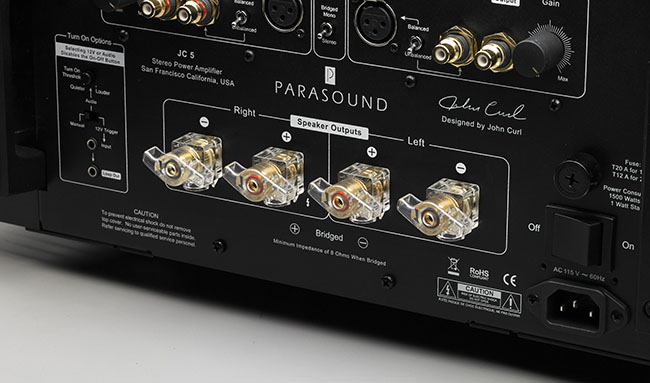
Party in the Back
The rear of any power amplifier is where the important stuff lives. In addition to the usual binding posts, RCA/XLR switches, and an IEC jack, there are also some unusual features: gain adjustment knobs, which I’ll come back to in a second, and a pair of “Loop Output” RCA jacks that allow a pair of JC5s to be linked in sequence for bi-amping which Parasound seems to believe offers sonic benefits over bridged mono operation for speakers with two sets of otherwise strapped binding posts.
Whad’ya have to gain?
Many years ago, I had a lovely sounding tube preamp that had too much gain for the amplifier I was using at the time. The volume knob was only usable between seven and nine o’clock, nowhere close to the meat of the preamp’s capacity, and it hummed a bit. That preamp always sounded its best in other people’s systems which, as you can imagine, was really annoying. Eventually, I gave up and sold it. That’s how I wound up with the Cary SLP-98p.
This brings me to my favorite rear-panel feature of the JC5: the aforementioned gain adjustment pots, one per channel. Although not entirely unheard of, there aren’t as many power amplifiers with this feature as there ought to be. Occasionally you’ll see a switch for high or low gain – some Bryston amps, as well as Parasound’s own JC1+, come to mind – but rarely what essentially amounts to full volume knobs. Those pots are incredibly useful for getting components to play well together, especially when blending gear from different manufacturers with varying outputs.
Parasound offers some useful applications: “They (the gain pots) can be used as Left/Right balance adjustments if the preamp is not equipped with a balance control. Also, if the JC5 is used in a bi-amp configuration with another brand of amplifier, the controls can compensate for differences in amplifier gain. Likewise, when using our stereo amplifiers in a vertical, stereo bi-amped configuration the gain controls allow for individual tailoring of the output to Tweeter/Mid and Woofer section of each speaker allowing you to dial in the correct sonic balance for the room and the speaker positioning in the room.”
In my system, with the JC5’s gain knobs turned all the way up, I could only use the volume knob on my Cary preamp to about 9:30, and that didn’t seem deep enough for the best sound quality. Also, I was getting a little tube rush through the speakers at idle. Lowering the gain on the JC5 by about ten percent eliminated the rush unless the volume was turned up super high and, more importantly, allowed the use of more of the volume knob on the preamp, which I think yields benefits particularly in dynamic snap and impact. My personal experience with the SLP-98 is it sounds its best at around eleven o’clock. Again, according to Parasound, “The level Gain/Level controls on the JC 5 are there to do exactly what you did with your Cary preamp.” Also, important to note lowering the gain does not reduce the power output of the amplifier as the pots are placed before the amplifier section in the signal chain.
In an early email exchange with Parasound’s Phil Jackson, it was recommended that the JC5 run in for around one-hundred and fifty hours before doing any serious listening. After going through the process, I couldn’t disagree. Straight out of the box, the amplifier sounded uptight and a little grainy with a constrained soundstage. The grain disappeared after just a few hours, but my system is usually shut down during the workweek, so one-hundred and fifty hours of actual playing time took a little over two months. The sound stage expanded relatively early in the process, easily extending out past the boundaries of the speakers, but the bass took a while drop. When it did, it seemed quite sudden, filling out the bottom end of my speakers in ways I did not realize they were capable of. That was about the point when I felt the JC5 was ready for prime time.
I can’t stress enough how important the break-in period is. If you hear a JC5 at a dealer, be sure to ask how long the amp has been burned in before you decide whether you like it or not. If they just took it out of the box and plugged it in, it is not being played in its best advantage.
Listening
I’ve made this observation before, and I’m sure I’ll make it again, but I strongly believe that people would listen to a more diverse variety of music if they would only hear that music through a really good high-fidelity system. This certainly applies to me.
One of the first records I listened to through the JC5 was Tennessee Ernie Ford’s Country Hits… Feelin’ Blue (Analog Productions APP 126, Capitol Records ST-2097 – 1964/2020), and it knocked my socks off. Having grown up in and around New York City, country music generally makes as much cultural sense to me as Snoop Dog would make to the Ladies Church Muffin Club down at the local presbytery. But that’s just me being a bit, well, New York-ish. This record sounds so good that my learned bias melts away as I’m drawn into the tunes. This stereo reissue is a simple recording with just acoustic guitar and upright bass accompanying Ford’s astonishing basso profundo. These songs are mostly tales of love stolen, love lost, and love redeemed, then love stolen again, with plenty of heartache dolloped on top. Ford completely fills the space between and a bit forward of the speakers, perhaps with a little added reverb, with the instruments slightly offset to either side behind him. The JC5’s contribution to this hoedown is midrange presence and scale. This amplifier throws an enormous soundstage leaving Ford’s voice to fill the room, so powerful and realistic that I kept coming back for more. That sound quality – and this really is an amazing recording – makes this music compelling, even to a city boy. This amplifier puts all of that out there with authority!
Up High
The JC5 is also the sweetest high-frequency amplifier I’ve ever had in my system. On recordings with detailed, airy highs, the treble elements are clear, resolved, and textural when required while banishing all but the worst treble brightness unless it is on the recording. On the stereo version of Shelly Manne and his Men Play Peter Gunn (Contemporary/Stereo Records S7205, 1959), a record that I’ve always thought of as a bit hot in the treble, exaggerated bite morphed into detailed extension, all there, but without the glare. On “Lamento De Limonero” from Leo Genovese’s Argentinosaurus (Newvelle-Records, NV006LP, 2016), Jack DeJohnette’s cymbals ring true, with shimmering sustain and discernable metallic brilliance. The JC5 offers a pellucid treble experience, uncontaminated by any shrill electronically generated exaggerations, colorations, or distortions (you know, like tubes). The amplifier’s treble clarity was so good that I found I had to further dial in my tonearm and cartridge, as very small changes in stylus rake and loading became significantly more valuable for fine-tuning than they’d been previously.
Down Low
I’ve really come to appreciate amplifiers with effortless deep bass delivery that comes with overkill levels of power, a capability my old amp did not possess. This is where the JC5’s 400 watts per channel comes into play. Aside from driving my Verity Fidelio speakers deeper and with far more definition than I’d previously known they were capable of, the reproduced bass notes flow with a wonderful sense of supreme ease.
On Irma Thomas’ Love is the Foundation (Newvelle-Records, NVN001, 2020) – another fantastic recording – which features both acoustic and electric bass, the two instruments are reproduced with correct tonality: the upright offering deep woody resonance, while the electric provides authoritative thump. On symphonic music, massed double-basses have more pronounced pluck and impact. Jazz recordings have more rhythmic drive. Most importantly, for the most part, that bass was clean, tight, well-textured, and corporeal, although I’ll have another word on that in a minute. I used to think the Verity Fidelios would benefit from a sub-woofer, but for most of the music I listen to – largely acoustic – that no longer seems at all necessary.
Not At All Slow
The JC5 is capable of going from whisper quiet to explosively loud and back again in a hair’s breadth. On “Private Investigations” from the recent Mo-Fi reissue of Dire Straits’ Love Over Gold (MFSL 2-469/Warner Brothers 1-23726), the track transitions from subtle synth backgrounds to finger-picked acoustic guitars, then to explosive power chords in fast bursts. Similarly, Shelly Manne’s rim shots on “Funky Blues” from that audiophile warhorse The Three (East Wind Direct-to-Disk EW-10001) made my wife jump out of her seat on multiple occasions. On that same record, Joe Sample’s piano can go from super soft pianissimo to fortississimo in a blink, and the punch has real weight behind it. The JC5 did not suffer so much as a soft hiccup with any of it. It just drove the music, steady and imperturbable.
The JC5 amplifier takes all of those elements and puts them together into wide, deep, layered soundstage with terrific image specificity. If this amplifier has any faults, they’re very minor and likely sins of omission rather than any real misstep. I was unable to identify any specific faults.
A Real Diplomat: System Matching
Complete neutrality is a difficult if not impossible thing to achieve. Hell, even Switzerland was lured off the fence recently. But if there were an amplification meter that swung from dry, ice-cold frigidity on the left to gooey glowing warmth on the right, with dead neutral at high-noon, the Parasound JC5 – in my system with my current equipment – would probably fall somewhere around one o’clock. The JC5 is a very transparent amplifier, capable of delivering the true majesty of many great recordings with plenty of revealing details, but it’s not analytical. It does start off in Class A, after all. There’s enough warmth with this amplifier to make music sound detailed and pleasant, though it seems probable that a solid-state pre might move the needle a bit.
 On the other hand, my Cary preamp is a tube lover’s dream: rich, dimensional, and a little over-saturated. Playing into the JC5, the Cary’s inherent character occasionally left the bass a bit wooly and therefore exaggerated; a little out of sync with the rest of the frequency spectrum. On Oscar Peterson’s We Get Requests (Verve V6-8606/Analog Productions 8606 2×45), featuring among the best recorded upright basses I’ve heard, my own preamp left Ray Brown sounding deep and woody, but sometimes a bit diffuse and imprecise. I’m reasonably sure it was the pre and not the JC5 because a different preamp amended the wooliness I was just complaining about.
On the other hand, my Cary preamp is a tube lover’s dream: rich, dimensional, and a little over-saturated. Playing into the JC5, the Cary’s inherent character occasionally left the bass a bit wooly and therefore exaggerated; a little out of sync with the rest of the frequency spectrum. On Oscar Peterson’s We Get Requests (Verve V6-8606/Analog Productions 8606 2×45), featuring among the best recorded upright basses I’ve heard, my own preamp left Ray Brown sounding deep and woody, but sometimes a bit diffuse and imprecise. I’m reasonably sure it was the pre and not the JC5 because a different preamp amended the wooliness I was just complaining about.
A friend brought over a line stage I really admire: a Bottlehead BeePre2, powered by a pair of 300b vacuum tubes, built from a kit. This preamp is exceptionally transparent, handily completing the trick of making my speakers completely disappear. With the BeePre2 installed, the bass snapped back into line, tighter with more detail and coherence, properly balanced with the rest of the music. The BeePre2 is still a tube preamp, so it isn’t solid-state iron-fisted, but with its solid and natural presentation, it cleaned up most of the minor warts. This was by no means a thorough or scientific test, but it is clear that JC5 is transparent enough to reveal differences in upstream components. I wasn’t able to get my hands on a good solid-state preamp during this review, but if the opportunity presents itself, I may write a follow-up. I’m pretty curious to hear how that would affect the sound.
Wrapping It Up
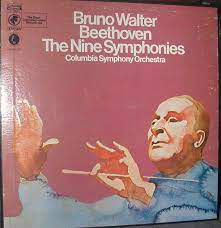 As I’m finishing this review, I’m spending a few days with the boxed set of Bruno Walter’s 1958/1959 cycle of the Columbia Symphony Orchestra performing all nine of Beethoven’s symphonies (Columbia Masterworks DS7-610, 1959) and especially with Symphony No.1. I enjoy this particular piece as much for its connections to Beethoven’s predecessors and mentors as for its own musical qualities. The influences of Mozart and especially Haydn, who had spent an uneasy year teaching composition to the recalcitrant Beethoven – are clearly represented through the instrumental arrangements, even though a decade had passed since their educational relationship had ended. While Beethoven maintains some musical connections with his predecessors, his innovations are also clearly on display. In the first movement, he modifies his motifs and major themes through the development with disarming frequency, requiring some attention to follow. What No. 1 lacks in the grand thematic largess of, say, the first movement of the Third Symphony (Eroica) it makes up for with the drama of the variations. I’m never simply able to settle into this first movement. Unlike many of the Haydn symphonies where you just get swept along, I always find myself really listening to what’s going on in Beethoven’s 1st, a wonderful musical outcome for any listener.
As I’m finishing this review, I’m spending a few days with the boxed set of Bruno Walter’s 1958/1959 cycle of the Columbia Symphony Orchestra performing all nine of Beethoven’s symphonies (Columbia Masterworks DS7-610, 1959) and especially with Symphony No.1. I enjoy this particular piece as much for its connections to Beethoven’s predecessors and mentors as for its own musical qualities. The influences of Mozart and especially Haydn, who had spent an uneasy year teaching composition to the recalcitrant Beethoven – are clearly represented through the instrumental arrangements, even though a decade had passed since their educational relationship had ended. While Beethoven maintains some musical connections with his predecessors, his innovations are also clearly on display. In the first movement, he modifies his motifs and major themes through the development with disarming frequency, requiring some attention to follow. What No. 1 lacks in the grand thematic largess of, say, the first movement of the Third Symphony (Eroica) it makes up for with the drama of the variations. I’m never simply able to settle into this first movement. Unlike many of the Haydn symphonies where you just get swept along, I always find myself really listening to what’s going on in Beethoven’s 1st, a wonderful musical outcome for any listener.
After 3,000 words, there’s not much I can add except this: I am enthusiastic about this amplifier. The Parasound JC5 delivers Beethoven’s 1st Symphony and everything else in an enormous, room-width soundstage with exceptionally good imaging, instrumental presentation, orchestral textures, and drive. You really can’t ask for more unless you invite the orchestra over for cocktails. It drove my speakers with newfound depth and authority and revealed details in great recordings that had previously been obscured. Most importantly, it delivered music in all of its glory and majesty. The JC5 is the best amplifier I’ve ever listened to in my own home. I am keeping it, and I am pleased to have it. Well done, Parasound.
Oh, and bring on the torch-wielding mob…my dog is ready for you.


greg simmons
Specifications:
- Output: 400 watts x 2 into 8 ohms, 600 watts x 2 into 4 ohms
- 12 watts x 2 pure class A.
- Output stable to 1.5 Ohms
- High-bias class A/AB operation
- Frequency Response: 5 Hz – 100 kHz, +0/-3dB
- Harmonic distortion
- Total Gain 29 dB
- Damping factor: 1000 at 20 Hz
- Price: $5,999.00
Address:
Parasound Products, Inc.
2250 McKinnon Avenue
San Francisco, CA 94124
Website: www.parasound.com
Greg’s Associated Equipment:
Analog Front End
SOTA Sapphire turntable w/Audio Creative Groovemaster III Tonearm
Rek-O-Kut T12h turntable w/Karmadon 12″ viscous damped unipivot tonearm
A Couple of Frankenstein Technics 1200s
Lyra Delos cartridge
Miyajima Spirit Mono cartridge
Audio-Technica OC/9-III cartridge
Audio-Technica AT33Sa cartridge
Digital Front End
Vacant
Amplification
Cary SLP-98P preamp w/ phono stage
Parasound JC5 Stereo Amplifier
Aurorasound SP-03H step-up transformer
Lyric Audio PS-10 MC/MM phono stage
Loudspeakers
Verity Audio Fidelity Encore
Magnepan MG-IIa
Cabling
Finley Audio Cirrus interconnects, speaker, and power cables.
A variety of other wires from Nordost, Cullen, AudioQuest, and MIT.
Accessories
AudioQuest Niagara 1200 power conditioner
Tice Box power conditioner
Nordost Sort Kones AC vibration dampers
Mapleshade Audio Rack
One thought on "Parasound JC5 Stereo Amplifier by Greg Simmons"
Leave a Reply
Stereo Times Masthead
Publisher/Founder
Clement Perry
Editor
Dave Thomas
Senior Editors
Frank Alles, Mike Girardi, Russell Lichter, Terry London, Moreno Mitchell, Paul Szabady, Bill Wells, Mike Wright, and Stephen Yan,
Current Contributors
David Abramson, Tim Barrall, Dave Allison, Ron Cook, Lewis Dardick, John Hoffman, Dan Secula, Don Shaulis, Greg Simmons, Eric Teh, Greg Voth, Richard Willie, Ed Van Winkle, Rob Dockery, Richard Doron, and Daveed Turek
Site Management Clement Perry
Ad Designer: Martin Perry









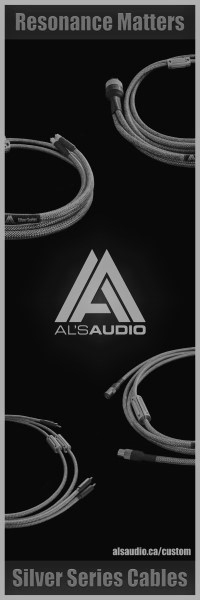
Nice article! I imagine it’s been around for a while. The JC-5 is my all-time favorite two channel amplifier! I even bought a McIntosh MC 312 for a bake off. I figured whichever one suited me best, the other would be relegated to the upstairs listening room. And or eventually find its way to one of my children’s homes. But they’re probably gonna be fine with class D. 😳🤷♂️ The only thing where I felt the McIntosh bested the Parasound, was the depth of the sound stage. Not the width. The depth. Parasound 9, McIntosh 1.